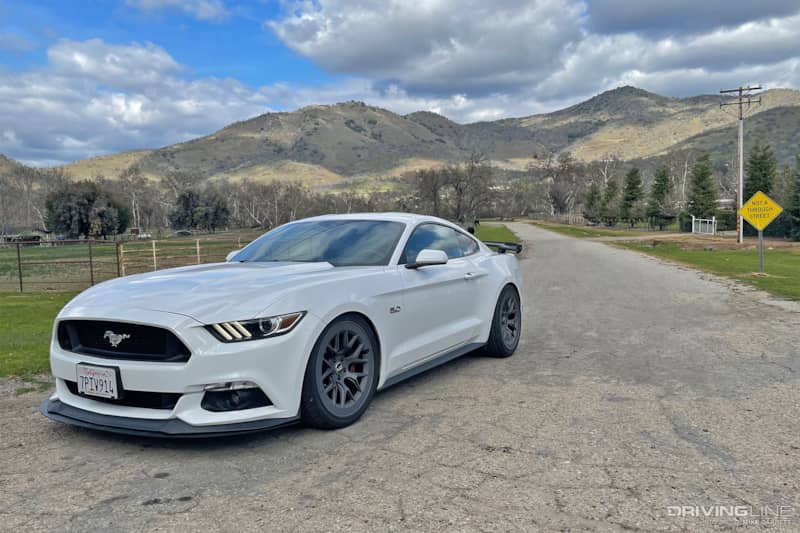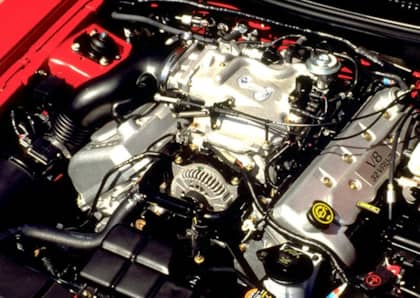Revenge of the 5.0: How the Coyote V8 Elevated the Modern Mustang to Greatness
When we last left off in our story of how the 5.0 liter engine has come to define the Ford Mustang for much of its history, Ford had just phased out the overhead valve 302 cubic inch small block prior to the Mustang’s 1996 model year. (Read the full story here)
The Modular Era
The 1996 Mustang GT would now be powered by an all new modular V8 that used overhead cam shafts and had absolutely nothing in common with the old pushrod Windsor small block.

And while it may not have seemed like it at the time, this period could be considered the start of modern V8 horsepower. Initially making just 215hp and 285 pound feet of torque, Ford would upgrade and improve the 4.6L for years to come.
And the higher end SVT Cobra models would also use a new 4.6 modular V8 but one that used double overhead cams and had four valves per cylinder. Always playing with a displacement disadvantage compared to the rival GM F-body, Mustang output gradually increased over the years while displacement remained the same.

Fast forward all the way to the year 2010 where the Mustang GT still has 4.6 liter V8 albeit one that now makes over 300 horsepower. Yet compared to the reborn Chevrolet Camaro SS with its 6.2 liter V8 and the new Dodge Challenger with its big Hemi V8s, the little 4.6 just couldn’t compete.
No Replacement for Displacement
So, in 2011, Ford gave the Mustang GT one of the biggest performance upgrades it’s ever seen. The old SOHC 4.6 was gone, and in its place a new DOHC, 32-valve V8 that once again displaced 5.0L, or 4,951cc to be exact. It was called the Coyote.

Now making 412hp and 390 pound feet of torque, the Mustang GT once again had the power to fight its rivals head on, and its new DOHC setup meant it could rev in a way most OHV V8s competitors couldn’t.

The Boss is Back
In many ways it was like the famed Boss 302 engine of 1969 and 1970—and for the 2012 model year Ford once again brought back the “Boss 302” package as rowdier, more powerful and more track ready version of the Mustang GT.

The Boss 302 version of 5.0 received numerous tweaks, including a new intake manifold, new cams, new internals and more. Horsepower rose to 444, and this would set the stage for more upgrades to the Coyote engine in the coming years.

In 2015 with debut of the all new S550 platform the Coyote 5.0 carried on as the powerplant of the Mustang GT, now with a chassis that was equally modernized.

5.0 Forever
Mid cycle updates like direct injection have brought further improvements to the Coyote, with the current base Mustang GT now making 460hp and 480 pound feet of torque from the same 5.0 liters.

Special versions of the Mustang, like the new Mach 1, have pushed the Coyote even further, with output uprated to an incredible 480 horsepower. All from a naturally aspirated 5.0 liter V8 that’s completely docile in normal driving.

So what’s in store for the future of the 5.0 liter Mustang? It’s hard to say at this point. While we are all but guaranteed to get an all electric Mustang sometime in the next five years, we expect the 5.0 to remain around, likely until the gasoline-powered Mustang is no longer sold.

They say that all good things must come to an end, but right now more than 50 years since the 302 first appeared, a new Mustang with a 5.0 liter V8 remains one of the coolest and most respected cars on the street.
More From Driving Line
- From Boss 302 to SVT Cobra: How the 5.0L V8 Became the Mustang's Most Famous Engine
- Interested in swapping a 5.0 Coyote engine into your vintage machine? We've got the basics right here.











